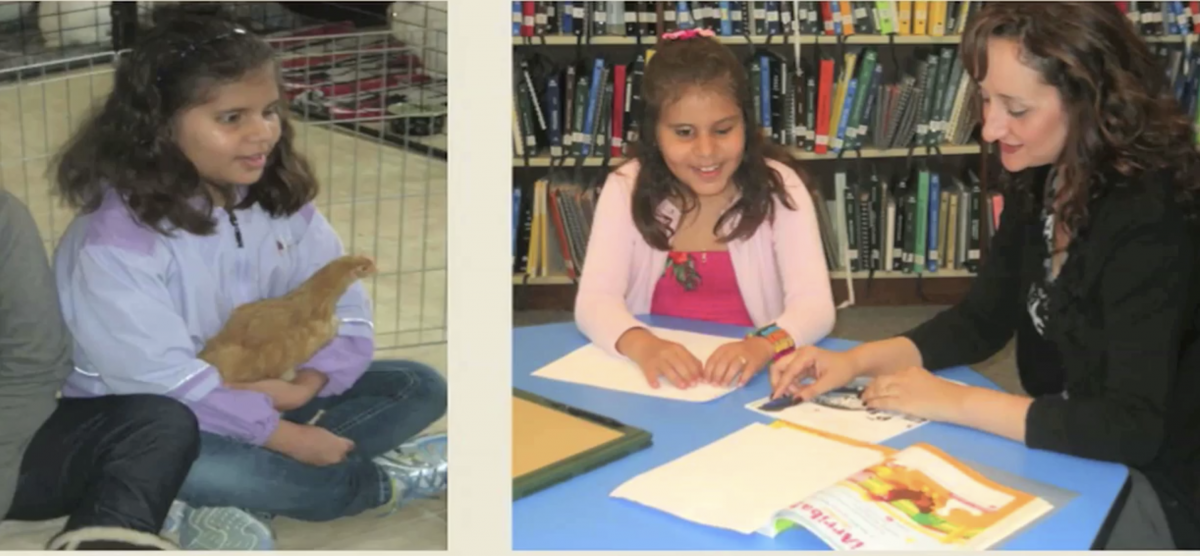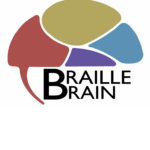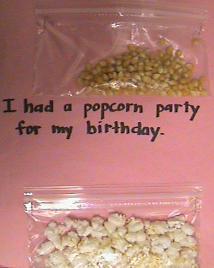Key Ideas and Details requires students to develop reading comprehension skills as they demonstrate knowledge of key concepts of reading. For example recalling information is essential to reading comprehension. Students who read braille are often able to recall factual details easily.

In the video below, Lizbeth Barclay discusses key idea and details, one part of the standards emphasizing specific strategies for skill development for students with visual impairments. This video outlines skills at the grade intervals of 1st, 6th, and 11th-12th, including the implications for students with visual impairments.
Download the video transcript.
The table below provides a detailed look at the CCSS CCR Anchor Standard Key Ideas and Details.
| Standard Number | Standard Description |
| 1. | Read closely to determine what the text says explicitly and to make logical inferences from it; cite specific textual evidence when writing or speaking to support conclusions drawn from the text. |
| 2. | Determine central ideas or themes of a text and analyze their development; summarize the key supporting details and ideas. |
| 3. | Analyze how and why individuals, events, and ideas develop and interact over the course of a text. |
The College and Career Readiness (CCR) Anchor Standards within Key Ideas and Details require the students to read closely and focus their attention on what the text actually says. Close reading of text guides students to take note of important aspects found in the text such as the use of vocabulary and how word meaning, tone, sentence structure, and paragraphs shape the message conveyed by the author in the text. Through close reading of text students acquire a deeper and richer understanding of the text (Boyles, 2012; Brown & Kappes, 2012).
Another emphasis of Key Ideas and Details is to determine the central or main idea in the text. As students read text they respond to questions such as who, what, when, where, why and how through verbal and/or written summarization (Kozdras & Day, 2013).The ability to identify the central or main idea and summarize information in complex text will lead students to academic success and prepare them to be college and career ready (McLaughlin & Overturf, 2013).
In Key Ideas and Details students will also examine the author’s development of relationships and interactions in the text. Specifically, students examine the text to determine how ideas or relationships evolve throughout the text (Kozdras & Day, 2013). Students must be able to ask and answer questions relating to the text and to identify and use various text structures (e.g., sequence or chronology and problem and solution). Mastering these skills will better prepare students for text analysis which is an essential skill in the CCSS (McLaughlin & Fisher, 2012).
In this video, Lizbeth Barclay shares strategies for skill development in key ideas and details for elementary age students. This includes a discussion of teaching strategies for key ideas and details at the elementary age level.
Download the video transcript.
Key Ideas and Details: Impact for Students who Read Braille
Students who use braille must have access to reading curricula beginning in the early grades in their primary learning media, furthermore, students who use braille require daily literacy instruction in their primary learning media. They may have limited experiences and may not be familiar with many concepts presented in texts. Therefore, teachers of the visually impaired must explicitly teach key concepts and guide students who read braille in developing the skills necessary to look closely at text, and to examine and discuss important details from the text.

In this video, Stephanie Herlich discusses key strategies and ideas teachers can use to help middle school through high school students achieve the college and career readiness reading standards within the category of key ideas and details. She includes the Expanded Core Curriculum (ECC) skills that VI students need to achieve the college and career readiness standards.
Download the video transcript.
Key Ideas and Details: Characteristics of Proficient Readers
Proficient readers of Key Ideas and Details understand that they must take an active role in their reading. They set goals as they read (McLaughlin, 2012). Students who are proficient in reading comprehension use a variety of reading strategies to assist them in deriving meaning from text (McLaughlin, 2012; Mills, 2009). Reading strategies used by proficient readers include: 1) activating prior knowledge, 2) making inferences, 3) demonstrating knowledge of text structure, 4) visualizing, 5) generating and answering questions, and 6) retelling and summarizing (Johnson, 2005; Mills, 2009). Proficient readers also self-monitor and understand how to incorporate reading strategies to assist them when they lose focus or don’t understand a word or phrase in text (Cummins, 2013).
Proficient readers of Key Ideas and Details understand that the purpose for reading is to determine meaning from text. Proficient readers use such strategies as rereading or skimming back through text to determine meaning (Presley & Afflerbach, 1995, as cited in Hedin & Conderman, 2013). When asked information such as the main idea or to summarize text the proficient reader will reread text to gain clarity or refer back to text to make connections. Proficient readers of Key Ideas and Details use their knowledge of text structure to foster their understanding of text (McLaughlin, 2012). ). As proficient readers incorporate reading strategies they will be able to meet the requirements of Key Ideas and Details as well as the other CCR Anchor Standards in the CCSS.
Proficient braille readers of Key Ideas and Details develop skills in the use of assistive technology such as Optical Character Recognition software, refreshable braille devices, and computers to aid them in meeting the requirements of key Ideas and Details. With proper supports in place students who read braille can be high achievers in the area of reading comprehension. According to a study conducted by Lowenfeld, Abel, and Hatlen (1969), students who read braille performed equally to their sighted peers in reading comprehension in 4th grade and were above students who are sighted in 8th grade. Reading tactually is similar to reading print, both are processes of recognizing meaningful wholes (Lowenfeld, Abel, & Hatlen, 1969).
Key Ideas and Details: Characteristics of Struggling Readers
Struggling readers of Key Ideas and Details may not realize the importance of deriving meaning from text (Hedin & Conderman, 2010). Struggling readers may think the purpose of reading is to decode an assigned reading passage. In Hedin and Conderman’s 2010 study, a struggling reader equated reading to the ability to decode words instead of reading for knowledge. Struggling readers of Key Ideas and Details may not be able to retell what they read in sequential order. They may not self-monitor when reading to ensure that they understand what they are reading. They may not know how to get back on track when they lose focus when reading. Struggling readers of Key Ideas and Details may not be able to cite specific examples from the text when discussing the text.
Struggling braille readers of Key Ideas and Details may not have knowledge or experiences relating to key concepts discussed in the text. Therefore, they are not able to make connections between characters or ideas presented in the text. They may lack motivation to read braille and not understand the importance of braille literacy. As a result they may think reading is not important. They may not be fluent braille readers. Therefore, they may focus their attention on reading the braille characters instead of focusing on what the text is saying.
Resources
Boyles, N. (2012). Closing in on close reading. Educational Leadership, 70(4), 36-41.
Brown, S., Kappes, L., & Aspen, I. (2012). Implementing the Common Core State Standards: A primer on “Close reading of text”, Aspen Institute.
Cummins, S. (2013). What Students Can Do When the Reading Gets Rough. Educational Leadership, 71(3), 69-72.
Kozdras, D., & Day, S. (2013). Common core state standards and economics: reading like a detective, writing like a reporter, and thinking like an economist. Social Studies Review, 52(1), 23-31.
McLaughlin, M. & Fisher, D. (2012). Teaching students to meet the common core standards in grades 6-12? Analyze this. Reading Today, 30(3), 12.
McLaughlin, M., & Overturf, B.J. (2013). The Common Core: Teaching K-5 students to meet the reading standards. Newark, DE: International Reading Association.
Mills, K. A. (2009). Floating on a sea of talk: Reading comprehension through speaking and listening. The Reading Teacher, 63(4), 325-329.
Hedin, L., & Conderman, G. (2010). Teaching students to comprehend informational text through rereading. The Reading Teacher, 63(7), 556-565.
This project was funded by the US Department of Education, Rehabilitation Services Administration (RSA), 84.235E Special Projects and Demonstrations for Providing Vocational Rehabilitation Services to Individuals with Severe Disabilities. The project is titled: Braille Brain: A Braille Training Program for pre/in-service Teachers of Students with Visual Impairments (TSVI), paraprofessionals, and other educational team members (H235E190002).

Braille Brain
Reading
- READING: Foundational Skills for Reading
- Integration of Knowledge and Ideas
- Vocabulary Acquisition and Use
- Braille Hand Movement and Refreshable Braille Displays
- Conventions of Standard English: Standard One
- Conventions of Standard English: Standard Two
- Writing and Language
- Craft and Structure
- Key Ideas and Details
- Best Practices for Teaching Braille and STEM to the Visually Impaired
- Assistive Technology to Support STEM Subjects for the Visually Impaired
- Compensatory Skills: A Focus on Organization
- Foundational Skills for STEM
- Math Instruction for Students with Visual Impairments
- Science Instruction for Students with Visual Impairments
- Tactile Graphics
STEM
- Best Practices for Teaching Braille and STEM to the Visually Impaired
- Assistive Technology to Support STEM Subjects for the Visually Impaired
- Compensatory Skills: A Focus on Organization
- Foundational Skills for STEM
- Math Instruction for Students with Visual Impairments
- Science Instruction for Students with Visual Impairments
- Tactile Graphics
- Braille Brain
- About Braille Brain
- Braille Training Program
- Foundational Skills for Reading
- Integration of Knowledge and Ideas
- Vocabulary Acquisition and Use
- Braille Hand Movement and Refreshable Braille Displays
- Conventions of Standard English: Standard One
- Conventions of Standard English: Standard Two
- Writing and Language
- Craft and Structure
- Key Ideas and Details
- Best Practices for Teaching Braille and STEM to the Visually Impaired
- Assistive Technology to Support STEM Subjects for the Visually Impaired
- Compensatory Skills: A Focus on Organization
- Foundational Skills for STEM
- Math Instruction for Students with Visual Impairments
- Science Instruction for Students with Visual Impairments
- Tactile Graphics



